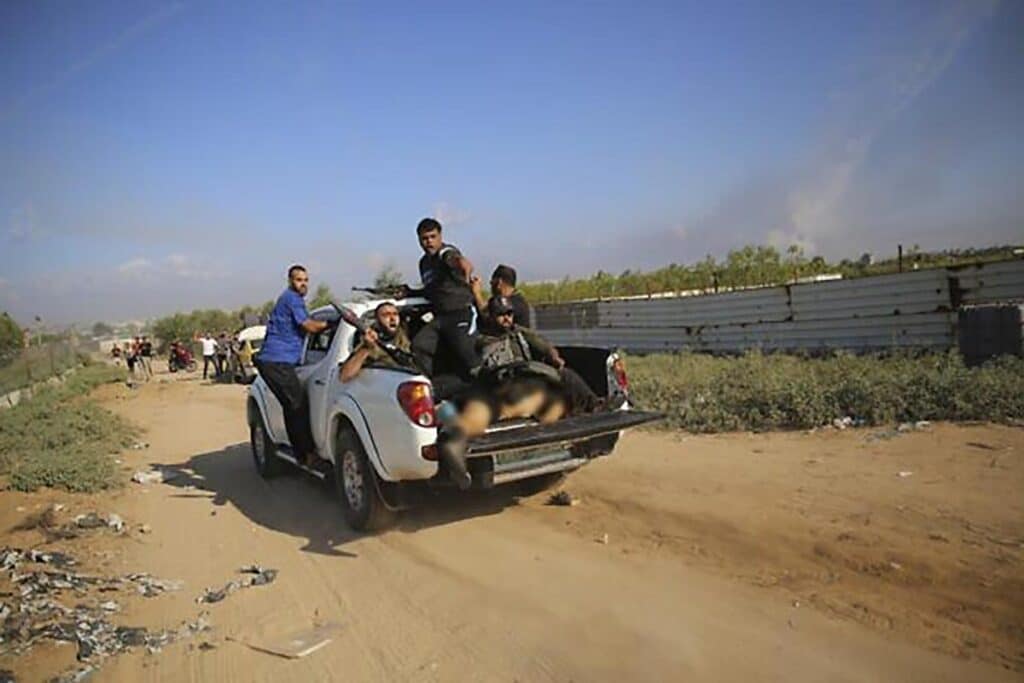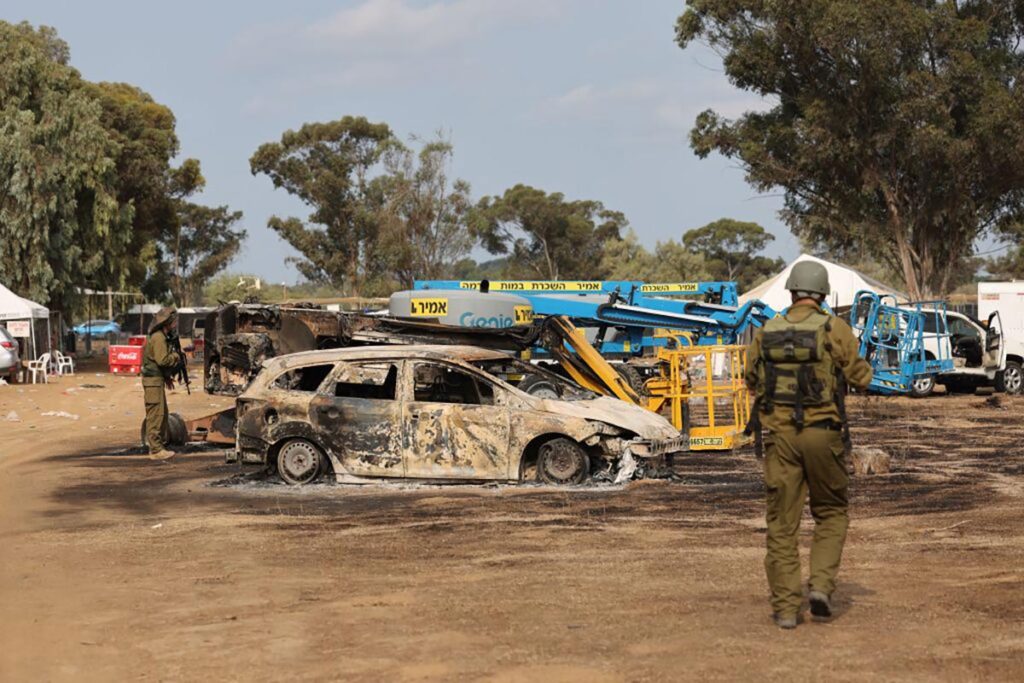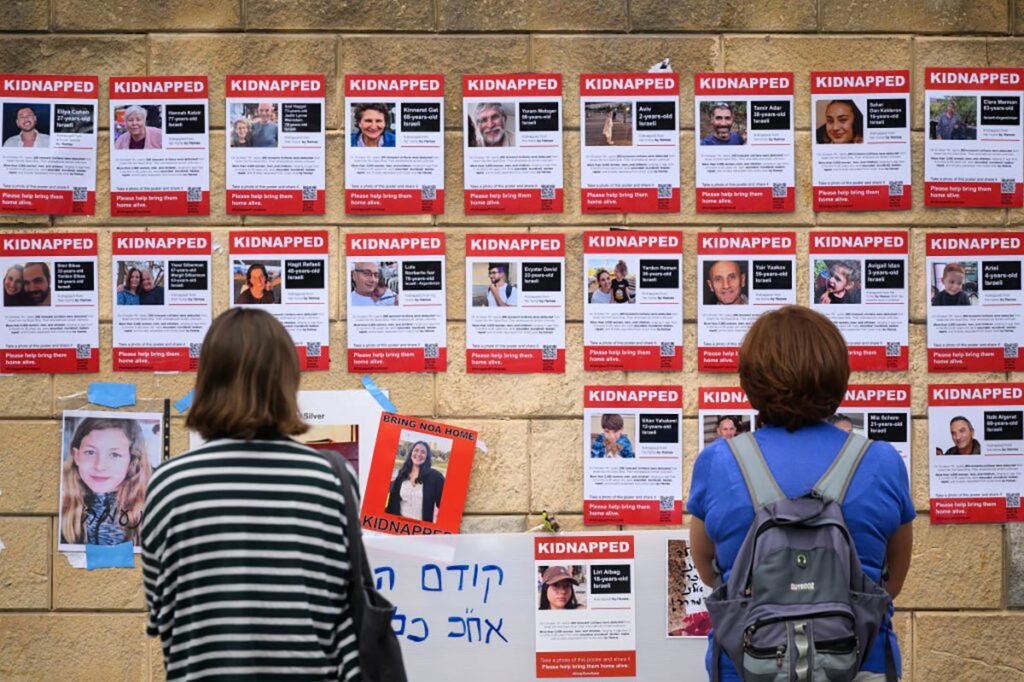
For the first time since the war between Israel and Hamas began, a large group of Arab and Muslim states have condemned the massacre Hamas carried out against Israel on Oct. 7, 2023.
The states — including Saudi Arabia, Egypt, Jordan, Qatar, and Turkey — issued the condemnation as part of a declaration made on Wednesday at the end of a United Nations conference focused on a two-state solution. The European Union and the Arab League also signed the document.
The 25-page document, which is also being called the “New York Declaration,” covers a lot of different issues, including how to handle Gaza after the war and how to promote the creation of a Palestinian state.

What does the declaration say about Hamas?
The declaration condemns Hamas once, stating, “We condemn the attacks committed by Hamas against civilians on the 7th of October.” In another line, the declaration calls for the terrorist group to release the hostages it’s holding.
Concerning the end of the war, the declaration adds that “Hamas must end its rule in Gaza and hand over its weapons to the Palestinian Authority, with international engagement and support, in line with the objective of a sovereign and independent Palestinian State.” This goal is reiterated in the annex of the declaration.
Why is this significant?
Up until now, most Arab and Muslim states have refused to condemn Hamas or the Oct. 7 attacks, though there are exceptions. The closest most have gotten to condemning the attacks are relatively vague statements condemning “any killing of civilians” or other wordings that don’t point blame at a particular party or a specific act, even though the statements usually explicitly condemned Israel.

It’s especially significant that Turkey and Qatar signed the document as they both serve as the main headquarters for Hamas leaders outside of Gaza and the West Bank. That means they’re both uniquely situated to put severe pressure on Hamas to comply with the demands made in the declaration.
Despite the inclusion of a condemnation of Hamas in the conference’s concluding document, the press releases from most of the Arab and Muslim states and organizations that took part in the U.N. conference didn’t mention Hamas at all.
Regardless, signing onto a document like this is still significant, although it’s important to note the context in which it’s being made: the rest of the over 10,000-word document.
What does the rest of the document say?
The New York Declaration is mainly focused on bringing about an end to the war in Gaza and creating a clear pathway to the implementation of the two-state solution, the creation of a Palestinian state alongside Israel.
The declaration calls for significant action to lead to a peaceful solution of the Israeli-Palestinian conflict, including some changes Israel has been demanding for decades.

However, the document puts almost all of the responsibility for the current situation and any future solution on Israel, while putting relatively little responsibility on the Palestinian Authority, the internationally recognized administration of Palestinians in the West Bank and Gaza.
The declaration calls for the PA to be the sole governing authority in Gaza and the West Bank, and for all other armed groups to be disarmed. It also calls for establishing a transitional administrative committee to run Gaza for the near future.
As part of the plan to have the PA take control of both Gaza and the West Bank, the document proposes the deployment of a temporary U.N. security mission to stabilize Gaza. The mission would protect Palestinian civilians, back up PA security forces, and provide security guarantees for both Israel and the Palestinians in full respect of their sovereignty.
Allies of Israel, including the United Arab Emirates, have already expressed interest in having their troops be part of such a security mission.
The document additionally notes the importance of reforming education to remove any extremist or violent content. It frames this as a problem with both the Israeli and the Palestinian education systems without further specification.
Repeated studies have found that many classes taught from elementary to high school in both the West Bank and Gaza include a variety of different content encouraging and glorifying violence, terrorism, and even genocide.

In addition, the document calls for other measures and programs to combat radicalization, incitement, dehumanization, discrimination, and hate speech, such as support for local organizations that encourage inter-communal dialogue. These measures would be monitored by international oversight meant to verify both Israel’s and the Palestinian Authority’s commitment to these objectives. The document didn’t clarify how such a mechanism would function.
While these are all major steps, the document doesn’t include any clear plans for enforcing this change with the Palestinian Authority or preventing a return to the existing situation.
In one clause, the document reaffirms the need for the PA to continue implementing its “credible reform agenda.” However, it doesn’t insist on measures to ensure that reform is actually carried out.
Over the past 20 years, the PA has repeatedly committed to sweeping reforms to fight corruption and combat incitement and hate, but it has failed to implement such reforms so far.
In contrast, the document includes a long list of measures meant to enforce Israel’s side of any arrangement.
These measures include harsh international sanctions and bans on any assistance or economic cooperation that may in any way go toward either settlements in the West Bank or Israelis in East Jerusalem, which includes the Old City of Jerusalem.
The document also goes into detail about which exact measures it wants Israel to implement, including specific legislation to specifically deter and punish settlers.
The declaration also consistently notes specific issues it sees with the Israeli side in the conflict, such as settlements, when providing examples of problems it aims to fix, while rarely mentioning any specific issues with the Palestinian side.
For example, the PA’s “pay for slay” program, which provides significant financial and social benefits for Palestinians who kill and injure Israelis and is a major incentive fueling terrorism, isn’t mentioned even once in the document. In contrast, Israeli settlers are mentioned 21 times.
In comparison to clauses about Israel, those understood as talking about Palestinian individuals, groups, or actions are almost all kept vague and could refer to either side of the conflict. In many cases, the clauses that were explicitly written to refer to both sides only noted issues with the Israeli side when providing examples of what they were referring to.
The New York Declaration’s vision for a future Palestinian state
When discussing the outcome of the peace process, the document largely sticks to the same proposals and talking points that have been at the center of the Israeli-Palestinian conflict for decades.
The document first and foremost calls for a Palestinian state to be formed on the basis of the borders that existed between Israel, Jordan, and Egypt before the Six-Day War in 1967. However, it also notes that the status of parts of this territory could change based on agreements between Israel and the Palestinians.
The reason changes could be made largely stems from the history of these border lines.
The lines in question are based on temporary border lines established by the ceasefire agreements that ended the 1948 War of Independence between Israel and several Arab states.
Under these agreements, the West Bank and East Jerusalem ended up controlled by Jordan, and the Gaza Strip was controlled by Egypt. Jews who had been living in these areas, some with roots going back centuries, were either forced out of their homes or killed. The Jewish Quarter of Jerusalem’s Old City was razed to the ground, and centuries-old synagogues were demolished.
The ceasefire agreements included a clause stressing that these border lines are not meant to be considered “in any sense” as a political or territorial boundary and are irrelevant to any rights, claims, or positions concerning the final status of any of the land.
The whole situation changed, however, after the Six-Day War in 1967, when Israel took control of the West Bank and Gaza. Since then, most Arab states and most of the international community have demanded that any Palestinian state be based, at minimum, on the old ceasefire lines, regardless of the original terms of the agreement.
However, since 1967, many Israelis have moved into East Jerusalem and the West Bank, setting up neighborhoods and settlements throughout these areas. At least some of these communities were established on the locations of Jewish communities uprooted by the 1948 war. (Communities were also established in Gaza after 1967, but these were all evacuated during Israel’s Disengagement from Gaza in 2005)
Due to that historical complexity and Judaism’s deep ties to Jerusalem, Israel opposes the establishment of a Palestinian state that would occupy the entirety of the West Bank and East Jerusalem, because Jews would no longer be able to access these areas. Many Israelis also fear that a state along those lines would pose a serious security threat.
As a result, previous peace talks have always been conducted with the recognition that there will need to be some land swaps from both sides. Negotiations on who gets what land, however, have always gotten stuck.
The document also calls for “upholding unchanged the legal and historical status quo in the Islamic and Christian Holy Sites in Jerusalem,” but doesn’t mention any of the issues concerning Jewish holy sites in the city, such as the Western Wall or the Temple Mount.
The historic Status Quo was implemented by the Ottoman Empire in the 1700s, but Jewish holy sites largely weren’t protected under it. A later version, put together by the U.N. in 1949, mentioned Jewish connections to the Western Wall and Rachel’s Tomb, but severely restricted their rights at the Western Wall and somewhat restricted their rights at Rachel’s Tomb.

Is the New York Declaration groundbreaking or much ado about nothing?
The condemnations of Hamas made in the New York Declaration sparked a lot of buzz, but due, at least partially, to the issues listed above, it’s unclear whether this is the start of a major change or just empty words.
French Foreign Minister Jean-Noël Barrot described the condemnation of Hamas as “historic and unprecedented.”
“The Arab countries – the countries of the region, of the Middle East – are, for the first time, condemning Hamas, condemning the Oct. 7 [attacks], calling for the disarmament of Hamas, calling for it to be excluded from participating in any way in Palestine’s governance, and clearly voicing their intention to have normalized relations with Israel in the future and be part of a regional organization on the lines of ASEAN in Asia or the OSCE in Europe, alongside Israel and the future State of Palestine,” Barrot said on Tuesday.
The Israeli Hostages and Missing Families Forum welcomed the condemnation as well.
“We welcome this important progress and the Arab League’s recognition that Hamas must end its rule in Gaza. Kidnapping innocent men, women, and children is a blatant violation of international law and must be unequivocally condemned,” the Forum said. “This joint call serves as a reminder that Hamas recently rejected a hostage deal and ceasefire agreement.”
“Hamas is a terrorist organization that has murdered and kidnapped innocent people, and continues to stand as a barrier to peace. If the international community truly seeks peace, it must join U.S. efforts by first demanding the release of all hostages, followed by an end to the fighting,” the Forum added.

On the other hand, Israel’s representative to the UN, Danny Danon, called the statement a “legitimization of terror.”
“While our hostages are still being held in Hamas tunnels in Gaza, some countries choose to focus on hollow declarations instead of investing their efforts in securing their release,” Danon wrote on X. “This legitimization of terror only pushes the region further away from progress. Anyone who truly seeks to move forward must start with a clear and unequivocal demand: the immediate return of the hostages and the disarmament of Hamas.”
Danon also referred to the conference as a “circus” that is “detached from reality.”
U.S. State Department spokesperson Tammy Bruce also rejected the U.N. conference, blasting it as “unproductive and ill-timed.”
“This is a publicity stunt that comes in the middle of delicate diplomatic efforts to end the conflict in Gaza. Far from promoting peace, the conference will prolong the war, will embolden Hamas, and reward its obstruction, and undermine real-world efforts to achieve real peace,” Bruce said.
“As Secretary Rubio has made clear, this effort is a slap in the face to the victims of Oct. 7 and a reward for terrorism. It keeps hostages trapped in tunnels. The United States will not participate in this insult but will continue to lead real-world efforts to end the fighting and deliver a permanent peace. Our focus remains on serious diplomacy, not stage-managed conferences designed to manufacture the appearance of relevance.”
Both Israel and the U.S. decided not to take part in the conference. It’s unclear if any states that attended raised any of Israel’s concerns during the event.
The document published this week isn’t final. The proposals in the document are meant to serve as the basis for further discussions.
Further decisions will likely be made during the U.N. General Assembly in September.
France, Canada, Malta, and the United Kingdom have committed over the past week to recognizing a Palestinian state in September. However, both the U.K. and Canada said they may change their decision depending on what both Israel and the Palestinian Authority do until then. Currently, 147 U.N. member states recognize a Palestinian state.

